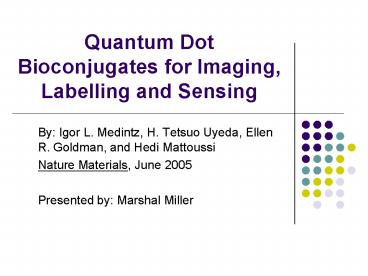Quantum Dot Bioconjugates for Imaging, Labelling and Sensing PowerPoint PPT Presentation
1 / 11
Title: Quantum Dot Bioconjugates for Imaging, Labelling and Sensing
1
Quantum Dot Bioconjugates for Imaging, Labelling
and Sensing
- By Igor L. Medintz, H. Tetsuo Uyeda, Ellen R.
Goldman, and Hedi Mattoussi - Nature Materials, June 2005
- Presented by Marshal Miller
2
Outline
- Applications
- Benefits of QDs
- Current Capabilities
- Manufacturing process
- Connection to bio-molecules
- Future directions
3
Bio-Applications
- in vivo and in vitro flourophores
- Cellular labelling (cancer cells)
- Deep-tissue imaging
- Efficient fluorescence resonance energy transfer
(FRET) donors - Understand interplay of biomolecules
4
QD vs Organic Labelling
- Organic and genetic fluorophores
- Low photobleaching threshold
- Broad absorption and emission profiles
- QDs properties
- High resistance to photobleaching and photo and
chemical degradation - Broad absorption, but narrow emission (FWHM
25-40nm) - High quantum yield
- High molar extinction coefficients (10-100x
organic) - Wide range (UV IR)
- Large Stokes shifts
CdSe core 13.5-24.0 ?
5
QD Properties
QD 630
Alexa 488
6
Current Capabilities
- Best QDs for bio-applications (June 2005) are
CdSe cores with ZnS layer - Easily reproducible/Refined chemistry
- Wide range of emission
- ZnS
- Passivates the core surface
- Protects core from oxidation
- Prevents Cd/Se from leeching into surrounding
solution - Produces higher photoluminescence yield
- Other colloidal nanocrystals ZnS, CdS, ZnSe,
CdTe, PbSe - Problems with reproducibility
- Inorganic passivation
7
Methods for preparing QD bioconjugates
- Production of CdSe
- TOPO dried by heating to 200 oC at 1 Torr for 20
min - Reaction flask stabilized at 300 oC at 1atm of
argon - A1.00 mL of Me2Cd added to 25.0 mL of TOP in
drybox - B 10.0 mL of TOPSe added to 15.0mL of TOP
- A added to B
- Removed from heat put in vigorously stirring
reaction flask - Temp falls to 180 oC, then heated to restore the
temp to 230-260 oC - Absorption spectra taken every 5-10 mins to
monitor growth - Raising the temp increases growth rate
- Once desired size is observed, portion of growth
solution transferred to a vial - Can isolate a series of sizes (15 to 115 ?) from
one batch
TOP trioctyl phosphine, TOPO trioctyl
phosphine oxide, Me2Cd Dimethylcadmium
Process from Synthesis and Characterization of
Nearly Monodisperse CdE Semiconductor
Nanocrystals, Murray et. al. J. Am. Chem. Soc.
1993
8
Connecting to Biomolecules
- Uses cap exchange by substituting TOP/TOPO with
bifunctional ligands (ex thiol) - Formation of polymerized silica shells
functionalized with polar groups - Preserves TOP/TOPO and uses amphiphilic diblock
and triblock copolymers and phospholipids
9
Problems/Future Directions
- Toxicity of inorganic Cd, Se, Zn, Te, Hg, Pb
- Toxins, neurotoxins, teratogens
- Reports of QDs damaging DNA
- Have been some long-term in vivo studies showing
no evidence of toxicity - No long term animal studies
- How are particles cleared metabolically?
- Do QDs mirror true in vivo behavior?
- Multiplexing (6-10 signals at varying
intensities) bar codes for synthetic products - Flexible bioconjugation
- Make processes more reproducible
10
The End
- Thank you for your attention
- Questions?
11
(No Transcript)

